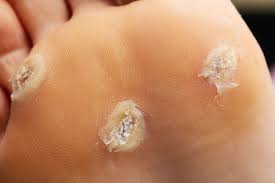Foot warts are small, raised growths that appear on the soles of the feet. These benign skin lesions develop when the human papillomavirus (HPV) infects the outer layer of skin on your feet. Understanding foot warts helps you recognize the condition early and seek appropriate treatment. Here is more information on the causes, symptoms, prevention methods, and treatment options available for this condition:
What Are Foot Warts?
Warts on the feet are skin growths caused by viral infections. The medical term for this condition is plantar warts, referring to their location on the plantar surface of the foot. These warts typically develop a thick, callus-like appearance due to the pressure from walking and standing.
Plantar warts differ from other types of warts because they grow inward rather than outward. The constant pressure from body weight causes them to flatten and develop beneath the skin surface. This inward growth pattern can make foot warts more painful than warts found elsewhere on the body.
What Causes Them?
Human papillomavirus (HPV) causes foot warts through direct contact with infected surfaces or individuals. The virus enters the skin through small cuts, scratches, or areas of broken skin on the feet. HPV thrives in warm, moist environments such as public showers, swimming pools, and locker rooms. Certain factors, such as a weakened immune system, increase the likelihood of developing foot warts.
What Are the Symptoms?
Several distinctive features characterize this condition. These growths typically appear on the sole of the foot and exhibit a rough, grainy texture. Small black dots, which are minute blood vessels, are sometimes visible within the wart.
Additional symptoms associated with this condition include:
- Pain during walking or standing.
- Increased discomfort with prolonged activity.
- Tenderness when the wart is pinched from its sides.
These growths can impact an individual’s normal walking pattern, as they unconsciously adjust to avoid pressure on the affected area. This compensatory action may result in discomfort in other regions of the feet, legs, or back.
How Do Podiatrists Prevent Them?
Podiatrists recommend several prevention strategies to reduce the risk of developing foot warts. Maintaining proper foot hygiene forms the foundation of prevention. This includes washing feet daily with soap and water and thoroughly drying them afterward.
Wearing protective footwear in public areas prevents direct contact with contaminated surfaces. Flip-flops or shower shoes should be worn in locker rooms, public showers, and around swimming pools. Avoid walking barefoot in these environments to reduce exposure risk. Podiatrists may also advise keeping feet dry and changing socks regularly.
How Are Foot Warts Treated?
Podiatrists offer several treatment options for foot warts, ranging from topical applications to minor surgical procedures. Topical treatments represent the first line of therapy for many foot warts and include prescription-strength medications applied directly to the wart. Acid removal involves using acid to gradually dissolve the wart tissue.
Cryotherapy involves freezing the wart with liquid nitrogen to destroy the infected tissue. This treatment typically requires multiple sessions and may cause temporary discomfort. The frozen tissue eventually falls off, allowing healthy skin to grow in its place.
Minor surgery becomes necessary when conservative treatments fail to resolve the condition. Surgical excision involves removing the wart and the surrounding infected tissue. This procedure provides immediate removal but requires proper wound care during the healing process.
Consult a Podiatrist Now
Warts on the feet require professional medical attention for proper diagnosis and treatment. While some cases may resolve on their own, seeking podiatric care can prevent complications and reduce the risk of spreading the infection. Schedule an appointment with a podiatrist if you suspect you have this condition.














